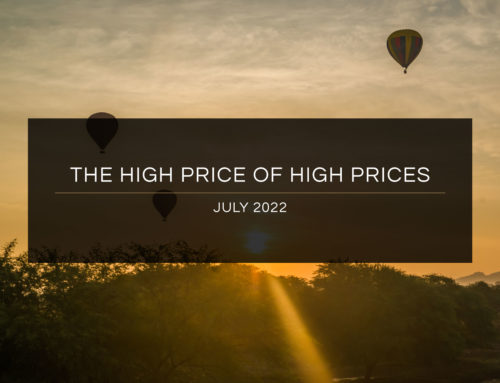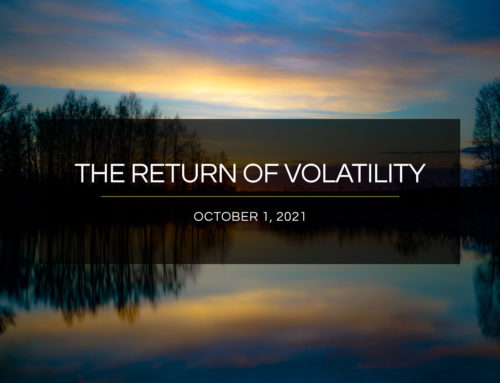THE OTHER SIDE OF THE PANDEMIC
February 2022
The world still has the Covid virus to deal with as a health concern, but the financial markets in 2022 are already dealing with the other side of the pandemic. The initial negative impact to the global economy in 2020 included business shutdowns and loss of productivity. To fill the hole caused by these interruptions, monetary and fiscal stimulus was provided at unprecedented levels. But as the saying goes, there is no free lunch. Indeed, printing and distributing money to offset lower economic activity has had consequences, namely high inflation. Some inflation can be good for the economy and financial markets, especially during a recession, but having too much is now forcing a reversal of the highly accommodative policies of the last two years as well as hampering consumers.
In general during the last two years many asset prices appreciated (i.e. real estate, stocks, bonds, commodities). The large government stimulus added to available cash flow for the financial system. Estimates are that economic disruptions in the US cost about three trillion dollars in economic activity lost. This was replaced, though, with stimulus somewhere around six trillion dollars. That excess stimulus is one of the major drivers of current inflation. The excess stimulus was spent, which boosted demand for goods and services, but also flowed into many financial assets.
From a fiscal perspective, inflation will continue to limit attempts at additional spending. While there may not be budget cuts any time soon, larger deficits due to higher interest payments on the debt could additionally weigh on policy decisions over time. From a monetary policy perspective, there is little choice for the Federal Reserve (and most central banks around the world) to become much less accommodative. The Fed has clearly communicated intentions to end bond purchases in February, start raising interest rates in March and begin reducing the amount of bonds that it holds sometime this summer.
The economy remains in decent shape and corporate earnings are generally still strong. However, the expectation of reduced monetary stimulus has already been showing up in financial markets through increased volatility and lower financial asset valuations. In many ways markets are starting to behave more normal again. It is not uncommon historically to have stock market drops of 10-15% in a given year. The excess liquidity provided by the Fed previously helped subdue this volatility, especially in 2021.
Between the rock and hard place is where we sit right now. If the Fed gets aggressive to slow inflation by raising short term interest rates and selling bonds it had purchased, it risks slowing the economy too much and starting a recession. If the Fed doesn’t act aggressively and inflation remains high, then the market may push long term interest rates higher which can be detrimental to financial asset values and consumer activity. The optimal scenario is for the Fed to act in a controlled manner and have inflation moderate reasonably soon. We, along with the Fed, don’t know for certain how quickly the price and wage pressures will subside. We do know, however, that markets can tend to overreact in different directions when circumstances change. One of the keys in navigating this environment will be looking for those moments where too much of a good or bad thing is already assumed by the markets.
Other factors will contribute to the market performance as the year goes on. Market uncertainty caused by the Russian aggression is certainly an issue, but geopolitics rarely has a sustained negative impact on markets. Election season this fall will determine whether the federal government remains under single party control. A split government tends to provide favorable conditions for markets due to higher certainty of the regulatory status quo. Another factor is China where the economy has diverged greatly from the rest of the world. Persistent virus-related shutdowns and a collapse in the construction industry have contributed to a country operating at a slower economic speed. This can ultimately be beneficial if the government adds stimulus while the rest of the world is removing it.
The scope of investment speculation witnessed over the last few years is also changing, hopefully for the better. Things like cryptocurrencies and so-called ‘meme’ stocks (stocks which are bought without regard to financial analysis) have defined this period where many people who were newly working from home or without a job suddenly started pouring money into assets that have little tangible value. The longer these types of speculative positions run, the more potential negative impact it has on markets. This alters the market landscape, but history has shown that these periods tend to be fleeting in the long run.
However, we certainly see a bright side to the inflation and market conundrum. As an investment team that believes in buying at attractive values, the added volatility may be a welcome investing period. Much of the artificial stimulus in the last two years created market distortions. We much prefer a return to the natural market order. Patience will be required, but there may be some very good opportunities to emerge. In general, we view this as a time to keep diversified and ensure there is the ability to take advantage of opportunities. This means different things for different people, but in any case, recognizing the unique attributes of this market is important.




